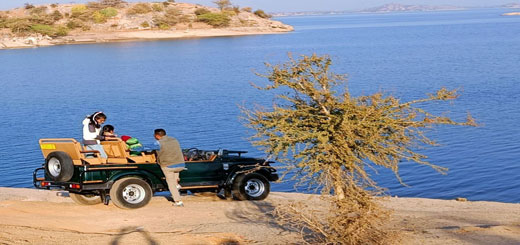- For Researvation :- +91-8955000999
- info@jawainaturestay.com

The majority of national parks and wildlife refuges are spread out across different zones in India. Indian forests are renowned for their high density, rough terrain, and mountains. Leopard safaris are a must if you want to experience something thrilling in India. Leopards are the only big cat species in that country that can be mounted on trees, so you will typically see them there. They differ from other big cats in that they prefer to live alone and stealthily, which makes them more lethal.Leopards are noted for their climbing prowess and are stronger and more adept than other wild animals. Leopards are also called as Pardus or Panthera on other continents. Most often found on the continents of Asia and Africa. Circular brown rosette stripes on the skin were used to identify leopards.
The following are the most well-known leopard sanctuaries that you can visit:
Jhalana leopard safari park, Rajasthan
There are over 30 leopards in all. It is the most well regarded tourist destination in India and well known for providing secure leopard viewing. The spotted monsters frequently get extremely close to human settlements and are seen by the inhabitants throughout the night on the roads. There hasn't been a single instance of a human attack, though. The likelihood of sighting leopards there is higher than you might think, and it is a safe area to do so. Other distinctive Indian species include wolves, blue bulls, sloth bears, chinkaras, and many others in addition to leopards. Not just inside the park, but also outside, leopard sightings are legendary in Jhalana.
Satpura National Park, Madhya Pradesh
With its thick forests, ravines, tight valleys, and sandstone peaks, it draws a lot of tourists each year. Predators like leopards, tigers, and wild canines are well adapted to Satpura's rough terrain and complex ecology since they are hard to see. Satpura is home to a wide variety of plants, animals, and trees, including countless birds, mammals, butterflies, and trees. Satpura's leopard population has greatly increased in recent years, increasing the frequency of sightings.
Kumbhalgarh Wildlife Sanctuary Rajasthan
The primary attraction in this area of the jungle is the Kumbhalgarh Fort. Either horseback riding or an open-air jeep ride are options for exploring this sanctuary. In terms of wildlife, you can see Indian wolves, Indian leopards, striped hyenas, sloth bears, nilgais, chausinghas, sambars, Golden Jackals, striped hyenas, chinkaras, Indian hares, jungle cats, as well as the leopard, the top predator. The Asiatic Lion Reintroduction Project, which continues to draw visitors from all over the world, has also included it.
Jim Corbett National Park
Tigers can be found in great numbers in Jim Corbett National Park, which is a part of the larger Corbett Tiger reserve. A white tiger might be seen as well, if you're lucky. Attempt fishing at the Kosi River, explore the Corbett Falls, and drive around the park to see the wildlife. The location's unique selling point is that it's the only park in India that permits overnight stays in the jungle. For a better experience, you can spend the night in a natural setting.
Bandipur National Park, Karnataka
It is renowned as Raja Maharajas' favourite hunting ground. The place is renowned for having flora and fauna that exist naturally and provide a habitat for many animals. The primary feature of that location is that it is also covered in a dry deciduous forest, which offers leopards and tigers a unique habitat. It is situated where the Western Ghats and the Deccan Plateau converge, and it serves as a habitat for many animals, including dholes, jackals, four-horned antelopes, Indian rock pythons, muggers, sloth bears, gaurs, Indian elephants, grey langurs, chital, and several species of birds in addition to leopards.
Jawai Leopard Reserve, Rajasthan
his little area has a wonderful environment and fusion ecosystem all around it. The number of leopards has been steadily rising due to this type of living environment. Jawai stands out from the rest of India's forest reserves because it is the only location where you may witness big cats living in caverns. You may spot leopards perched on a rock here instead of the normal lush woodlands and trees, where they prefer to hide out. If you are going on a leopard safari in Jawai, you won't have to worry about seeing the big cat because it usually roams around the hills.The sizable reservoir is home to several resident and migratory bird species like Osprey, Pelicans,Indian Courser, Bar-Headed Geese, Waterfowl, pratincoles,pipits, larks, Sarus Craneand other raptors. No matter what time of year you visit, this place has the best ecosystem.
Over the previous few decades, a variety of animals have lived in these forests. Cats are known for their larger size, especially the most common variety. However, leopards are a more delicate and diminutive species. One of the greatest locations in India for seeing leopards are all of the spots mentioned above. However, Jawai ought to be at the top of your list if you want to view these elusive species in a different setting with a higher chance of spotting them.